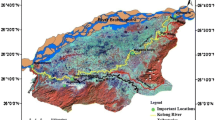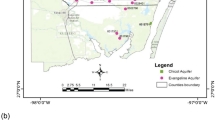Abstract
In this paper, we have studied the comparative hydrogeochemistry of the Ken and Betwa Rivers of Bundelkhand area, considering the importance of the Ken–Betwa River linking project (KBLP) in India. Factor analysis and principal component analysis (PCA) has been done to identify the highly correlated and interrelated water-quality parameters. All the physico-chemical parameters for both rivers are within the highest desirable or maximum permissible limit set by WHO (World Health Organization) except some anions viz. \(\mathrm{NO}_{3}^{-}\), Cl−, \(\mathrm{SO}_{4}^{2-}\) and F− at some sampling points. The Ken River showed a high spatial variability and significant ionic concentration due to the higher geological and pedological watershed richness as well as absence of pollution from anthropogenic point sources. The Betwa River showed a low spatial variability and higher mineralization due to the anthropogenic point sources that exist downstream. This preliminary study shows the spatio-temporal variability of the hydrogeochemical parameters of the Ken–Betwa River basin.
Similar content being viewed by others
References
Ahmad SM (1984) Hydrogeological investigations for augmenting water supply in drought affected areas of Banda district, Uttar Pradesh. Central Ground Water Board unpublished report, Lucknow, India
Alaez MCF, Alaez MF, Calabuig EL (1988) Variation in time and space of some physical and chemical variables in the Bernesga River, León, Spain. Ann Limnol 24(3):285–291
APHA (1995) Standard methods for the examination of water and waste water, 19th edn. American Public Health Association, Washington
Avtar R, Singh CK, Shashtri S, Singh A, Mukherjee S (2010) Identification and analysis of groundwater potential zones in Ken–Betwa river linking area using remote sensing and geographic information system. Geocarto Inte 25(5):379–396
Bhattacharya DS (1970) Geological and geophysical investigation of basaltic layer in Archaean terrain of eastern India. Bull Geol Soc Am 81(10):3073–3078
Boyacioglu H, Boyacioglu H (2007) Surface water quality assessment by environmetric methods. Environ Monit Assess 131:371–376
Carpenter SR, Caraco NF, Correll DL, Howarth RW, Sharpley AN, Smith VH (1998) Nonpoint pollution of surface waters with phosphorus and nitrogen. Ecol Appl 8(3):559–568
Davis JC (2002) Statistics and data analysis in geology. Wiley, (ASIA) pte Ltd, Singapore
Duan L, Hao J, Xie S, Zhou Z, Ye X (2002) Determining weathering rates of soils in China. Geoderma 110(3–4):205–225
Greenway DR (1987) Vegetation and slope stability. In: Anderson MG, Richards KS (eds) Slope stability. Wiley, New York
Guissani B, Monticelli D, Gambillara R, Pozzi A, Dossi C (2008) Three way principal component analysis of chemical data from lake Como watershed. Microchem J 88(2):160–166
Helena B, Pardo R, Vega M, Barrado E, Fernandez JM, Fernandez L (2000) Temporal evolution of groundwater composition in an alluvial aquifer (Pisuerga river, Spain) by principal component analysis. Water Res 34:807–816
Hem JD (1985) Study and interpretation of the chemical characteristics of natural water, 3rd edn. United States Government Printing Office, Washington
Hunsaker CT, Levine DA (1995) Hierarchical approaches to the study of water quality in rivers. Bioscience 45(3):193–203
Jain SK, Agarwal PK, Singh VP (2007) Hydrology and water resources of India. Springer, Dordrecht
Jayaprakash M, Giridharan L, Venugopal T, Krishna SPK, Periakali P (2008) Characterization and evaluation of the factors affecting the geochemistry of groundwater in Neyveli, Tamil Nadu, India. Environ Geol 54(4):855–867
Kazi TG, Arain MB, Jamali MK, Jalbani N, Afridi HI, Sarfraz RA, Baig JA, Shah AQ (2009) Assessment of water quality of polluted lake using multivariate statistical techniques: a case study. Ecotoxicol Environ Saf 72(2):301–309
Krueger K (2007) Assessment of the India river linking plan: a closer look at the Ken–Betwa pilot link. MSc Dissertation, University of Michigan
Kumar P, Kumar M, Ramanathan AL, Tsujimura M (2010) Tracing the factors responsible for arsenic enrichment in groundwater of the middle Gangetic Plain, India: a source identification perspective. Environ Geochem Health 32:129–146
Lawrence FW, Upchurch SB (1982) Identification of recharge areas using geochemical factor analysis. Ground Water 20:680–687
Li Y, Xu L, Li S (2009) Water quality analysis of the Songhua River basin using multivariate techniques. J Water Resour Prot 1(2):110–121
Liu CW, Lin KH, Kuo YM (2003) Application of factor analysis in the assessment of groundwater quality in black foot disease in Taiwan. Sci Total Environ 313:77–89
Lovchinov V, Tsakovski S (2006) Multivariate statistical approaches as applied to environmental physics studies. Cent Eur J Phys 4(2):277–298
Ma H, Liu L, Chen T (2010) Water security assessment in Haihe River basin using principal component analysis based on Kendall tau. Environ Monit Assess 163(1–4):539–544
Mazlum N, Ozer A, Mazlum S (1999) Interpretation of water quality data by principal components analysis. Turk J Eng Environ Sci 23:19–26
Mukherjee S (1991) Ground water appraisal report Hamirpur district Uttar Pradesh, Remote sensing applications centre Uttar Pradesh: Lucknow. Unpublished technical report no RSAC; GED91:02, UPRSA, 881
NWDA (National Water Development Agency) (2007) Ken–Betwa link project feasibility report [Online]. Available: http://nwda.gov.in/index3.asp?sublink2id=23?. Accessed 25 April 2008
Palma P, Kuster M, Alvarenga P, Palma VL, Fernandes RM, Soares AMVM, Alda M, Barcelo D, Barbosa IR (2009) Risk assessment of representative and priority pesticides, in surface water of the Alqueva reservoir (south of Portugal) using on-line phase extraction-liquid chromatography-tandem mass spectrometry. Environ Int 35:545–551
Sarbu C, Pop HF (2005) Principal component analysis versus fuzzy principal component analysis. A case study: the quality of Danube water (1985–1996). Talanta 65:1215–1220
Sharma RP (1979) Origin of the pyrophillite—diaspore deposits of the Bundelkhand complex, central India. Miner Depos 14:343–352
Simeonov V, Stratis JA, Samara C, Zachariadis G, Voutsa D, Anthemidis A, Sofoniou M, Kouimtzis T (2003) Assessment of the surface water quality in Northern Greece. Water Res 37:4119–4124
Singh KP, Malik A, Sinha S (2005) Water quality assessment and apportionment of pollution sources of Gomti River (India) using multivariate statistical techniques: a case study. Anal Chim Acta 538:355–374
Singh CK, Shashtri S, Mukherjee S (2010) Integrating multivariate statistical analysis with remote sensing and GIS for geochemical assessment of groundwater quality: a case study of Rupnagar District in Shiwaliks of Punjab, India. Earth Environ Sci. doi:10.1007/s12665-010-0625-0
Souza ADG, Tundisi JG (2000) Hidrogeochemical comparative study of the jaú and jacaré-guaçu river watersheds, São Paulo, Brazil. Rev Bras Biol 60(4):563–570
Wunderlin DA, Diaz MP, Ame MV, Pesce SF, Hued AC, Bistoni MA (2001) Pattern recognition techniques for the evaluation of spatial and temporal variations in water quality. A case study: Suquia river basin (Cordoba, Argentina). Water Res 35:2881–2894
Zhang X, Wang Q, Liu Y, Wu J, Yu M (2010) Application of multivariate statistical techniques in the assessment of water quality in the southwest new territories and Kowloon, Hong Kong. Environ Monit Assess. doi:10.1007/s10661-010-1366-y
Author information
Authors and Affiliations
Corresponding author
Rights and permissions
About this article
Cite this article
Avtar, R., Kumar, P., Singh, C.K. et al. A Comparative Study on Hydrogeochemistry of Ken and Betwa Rivers of Bundelkhand Using Statistical Approach. Water Qual Expo Health 2, 169–179 (2011). https://doi.org/10.1007/s12403-010-0035-2
Received:
Revised:
Accepted:
Published:
Issue Date:
DOI: https://doi.org/10.1007/s12403-010-0035-2




